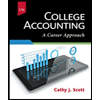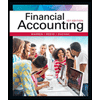
FINANCIAL & MANAGERIAL ACCOUNTING
9th Edition
ISBN: 9781266265549
Author: Wild
Publisher: MCG
expand_more
expand_more
format_list_bulleted
Question
Chapter 3, Problem 38QS
To determine
Introduction:
Financial statements: The financial statements of a company are prepared at the end of an accounting year to calculate the total liabilities, total assets, net profit or loss, and increase or decrease in cash during the year. The financial statements are used by various external and internal parties.
To prepare: The partial worksheet for the given account balance and adjustments.
Expert Solution & Answer
Want to see the full answer?
Check out a sample textbook solution
Students have asked these similar questions
Please provide the correct answer to this financial accounting problem using valid calculations.
The stockholders' equity accounts of Grouper Corp. on January 1, 2025, were as follows.
Preferred Stock (7%, $100 par noncumulative, 8,500 shares authorized)
$510,000
Common Stock ($4 stated value, 510,000 shares authorized)
1,700,000
Paid-in Capital in Excess of Par-Preferred Stock
25,500
Paid-in Capital in Excess of Stated Value-Common Stock
816,000
Retained Earnings
1,169,600
Treasury Stock (8,500 common shares)
68,000
During 2025, the corporation had the following transactions and events pertaining to its stockholders' equity.
Feb. 1
Issued 8,500 shares of common stock for $51,000.
Mar. 20
Purchased 1,700 additional shares of common treasury stock at $7 per share.
Oct.
1
Nov. 1
Dec. 1
Declared a 7% cash dividend on preferred stock, payable November 1.
Paid the dividend declared on October 1.
Declared a $0.50 per share cash dividend to common stockholders of record on December 15, payable December 31, 2
Dec. 31 Determined that net income for the year was $477,000. Paid the dividend…
Baxter Enterprises wants to earn a pre-tax income of $45,000. The
company has fixed costs of $105,000, and the contribution margin per
unit is $7.50, How many units must be sold to reach the target income?
Options:
a) 18,000
b) 20,000
c) 22,000
d) 25,000
Chapter 3 Solutions
FINANCIAL & MANAGERIAL ACCOUNTING
Ch. 3 - Prob. 1QSCh. 3 - Computing accrual and cash income C1 In its first...Ch. 3 - Identifying accounting adjustments P1 Classify the...Ch. 3 - Prob. 4QSCh. 3 - Prepaid (deferred) expenses adjustments P1 For...Ch. 3 - Prepaid (deferred) expense adjustments P1 For each...Ch. 3 - Prob. 7QSCh. 3 - Prob. 8QSCh. 3 - Prob. 9QSCh. 3 - Prob. 10QS
Ch. 3 - Prob. 11QSCh. 3 - Prob. 12QSCh. 3 - Prob. 13QSCh. 3 - Prob. 14QSCh. 3 - Prob. 15QSCh. 3 - Prob. 16QSCh. 3 - Prob. 17QSCh. 3 - Prob. 18QSCh. 3 - Prob. 19QSCh. 3 - Prob. 20QSCh. 3 - Prob. 21QSCh. 3 - Prob. 22QSCh. 3 - Prob. 23QSCh. 3 - Identifying post-closing accounts P5 Identify...Ch. 3 - identifying the accounting cycle C2 List the...Ch. 3 - Prob. 26QSCh. 3 - Prob. 27QSCh. 3 - Prob. 28QSCh. 3 - Prob. 29QSCh. 3 - Prob. 30QSCh. 3 - Prob. 31QSCh. 3 - Prob. 32QSCh. 3 - Prob. 33QSCh. 3 - Prob. 34QSCh. 3 - Prob. 35QSCh. 3 - Prob. 36QSCh. 3 - Prob. 37QSCh. 3 - Prob. 38QSCh. 3 - Prob. 39QSCh. 3 - Prob. 40QSCh. 3 - Prob. 1ECh. 3 - Prob. 2ECh. 3 - Prob. 3ECh. 3 - Prob. 4ECh. 3 - Prob. 5ECh. 3 - Prob. 6ECh. 3 - Prob. 7ECh. 3 - Prob. 8ECh. 3 - Prob. 9ECh. 3 - Prob. 10ECh. 3 - Prob. 11ECh. 3 - Prob. 12ECh. 3 - Prob. 13ECh. 3 - Prob. 14ECh. 3 - Prob. 15ECh. 3 - Prob. 16ECh. 3 - Prob. 17ECh. 3 - Prob. 18ECh. 3 - Prob. 19ECh. 3 - Prob. 20ECh. 3 - Prob. 21ECh. 3 - Prob. 22ECh. 3 - Prob. 23ECh. 3 - Prob. 24ECh. 3 - Prob. 25ECh. 3 - Prob. 26ECh. 3 - Prob. 27ECh. 3 - Prob. 28ECh. 3 - Prob. 29ECh. 3 - Prob. 30ECh. 3 - Prob. 31ECh. 3 - Prob. 32ECh. 3 - Prob. 33ECh. 3 - Prob. 34ECh. 3 - Prob. 35ECh. 3 - Prob. 36ECh. 3 - Prob. 37ECh. 3 - Prob. 1PSACh. 3 - Prob. 2PSACh. 3 - Prob. 3PSACh. 3 - Prob. 4PSACh. 3 - Prob. 5PSACh. 3 - Prob. 6PSACh. 3 - Prob. 7PSACh. 3 - Prob. 8PSACh. 3 - Prob. 9PSACh. 3 - Prob. 10PSACh. 3 - Prob. 11PSACh. 3 - Prob. 1PSBCh. 3 - Prob. 2PSBCh. 3 - Prob. 3PSBCh. 3 - Prob. 4PSBCh. 3 - Prob. 5PSBCh. 3 - Prob. 6PSBCh. 3 - Prob. 7PSBCh. 3 - Prob. 8PSBCh. 3 - Prob. 9PSBCh. 3 - Prob. 10PSBCh. 3 - Prob. 11PSBCh. 3 - No Account Title Debit Credit 101 Cash $38,264 106...Ch. 3 - Prob. 1GLPCh. 3 - Prob. 2GLPCh. 3 - Prob. 3GLPCh. 3 - Prob. 4GLPCh. 3 - Prob. 1.1AACh. 3 - Prob. 1.2AACh. 3 - Prob. 1.3AACh. 3 - Prob. 1.4AACh. 3 - Prob. 2.1AACh. 3 - Prob. 2.2AACh. 3 - Prob. 2.3AACh. 3 - Prob. 2.4AACh. 3 - Prob. 3.1AACh. 3 - Prob. 3.2AACh. 3 - What is the difference between the cash basis and...Ch. 3 - Why is the accrual basis of accounting generally...Ch. 3 - What type of business is most likely to select a...Ch. 3 - Prob. 4DQCh. 3 - Prob. 5DQCh. 3 - Prob. 6DQCh. 3 - Prob. 7DQCh. 3 - Prob. 8DQCh. 3 - Prob. 9DQCh. 3 - Prob. 10DQCh. 3 - Prob. 11DQCh. 3 - Prob. 12DQCh. 3 - Prob. 13DQCh. 3 - Prob. 14DQCh. 3 - Prob. 15DQCh. 3 - Prob. 16DQCh. 3 - Prob. 17DQCh. 3 - Prob. 18DQCh. 3 - Prob. 1BTNCh. 3 - Prob. 4BTN
Knowledge Booster
Similar questions
- Please explain the solution to this general accounting problem with accurate principles.arrow_forwardNeed answer step by step.arrow_forwardMERCIER MANUFACTURING Fabricating Department Production Cost Report-Weighted-Average Phycloal Units Total Costs Prior Department Material Costs Manufacturing Labor Overhead Flow of Production Units Units to be accounted for Beginning WIP inventory Units started this period 15,000 75,000 Total units to be accounted for 90,000 Units accounted for. Units completed and transferred out: From beginning inventory 15,000 Started and completed currently 60,000 Total transferred out 75,000 10,500 Units in ending WIP inventory 30,000 Total units accounted for 105,000 10,500 Costs to be accounted for. Costs in beginning WIP inventory Current period costs Total costs to be accounted for $ 0 $ Cost per equivalent unit Prior department costs Materials Labor Manufacturing overhead Costs accounted for. Costs assigned to units transformed out: Prior department costs Materials Labor Manufacturing overhead Total costs of units transfered out Costs assigned to ending WIP inventory: Prior department costs…arrow_forward
- Give correct answer with correct approach.arrow_forwardPlease help me solve this general accounting question using the right accounting principles.arrow_forwardIf a business has revenue of $677,000, cost of goods sold of $214,000, operating expenses of $157,000, and pays $70,000 in taxes, what is the net income?arrow_forward
arrow_back_ios
SEE MORE QUESTIONS
arrow_forward_ios
Recommended textbooks for you
- Century 21 Accounting Multicolumn JournalAccountingISBN:9781337679503Author:GilbertsonPublisher:Cengage
 College Accounting (Book Only): A Career ApproachAccountingISBN:9781337280570Author:Scott, Cathy J.Publisher:South-Western College Pub
College Accounting (Book Only): A Career ApproachAccountingISBN:9781337280570Author:Scott, Cathy J.Publisher:South-Western College Pub  Financial AccountingAccountingISBN:9781337272124Author:Carl Warren, James M. Reeve, Jonathan DuchacPublisher:Cengage Learning
Financial AccountingAccountingISBN:9781337272124Author:Carl Warren, James M. Reeve, Jonathan DuchacPublisher:Cengage Learning College Accounting, Chapters 1-27AccountingISBN:9781337794756Author:HEINTZ, James A.Publisher:Cengage Learning,Principles of Accounting Volume 1AccountingISBN:9781947172685Author:OpenStaxPublisher:OpenStax College
College Accounting, Chapters 1-27AccountingISBN:9781337794756Author:HEINTZ, James A.Publisher:Cengage Learning,Principles of Accounting Volume 1AccountingISBN:9781947172685Author:OpenStaxPublisher:OpenStax College


Century 21 Accounting Multicolumn Journal
Accounting
ISBN:9781337679503
Author:Gilbertson
Publisher:Cengage

College Accounting (Book Only): A Career Approach
Accounting
ISBN:9781337280570
Author:Scott, Cathy J.
Publisher:South-Western College Pub

Financial Accounting
Accounting
ISBN:9781337272124
Author:Carl Warren, James M. Reeve, Jonathan Duchac
Publisher:Cengage Learning

College Accounting, Chapters 1-27
Accounting
ISBN:9781337794756
Author:HEINTZ, James A.
Publisher:Cengage Learning,

Principles of Accounting Volume 1
Accounting
ISBN:9781947172685
Author:OpenStax
Publisher:OpenStax College